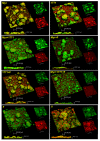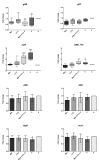Modulation of Lipoteichoic Acids and Exopolysaccharides Prevents Streptococcus mutans Biofilm Accumulation
- PMID: 32397430
- PMCID: PMC7249192
- DOI: 10.3390/molecules25092232
Modulation of Lipoteichoic Acids and Exopolysaccharides Prevents Streptococcus mutans Biofilm Accumulation
Abstract
Dental caries is a diet-biofilm-dependent disease. Streptococcus mutans contributes to cariogenic biofilms by producing an extracellular matrix rich in exopolysaccharides and acids. The study aimed to determine the effect of topical treatments with compound 1771 (modulates lipoteichoic acid (LTA) metabolism) and myricetin (affects the synthesis of exopolysaccharides) on S. mutans biofilms. In vitro S. mutans UA159 biofilms were grown on saliva-coated hydroxyapatite discs, alternating 0.1% sucrose and 0.5% sucrose plus 1% starch. Twice-daily topical treatments were performed with both agents alone and combined with and without fluoride: compound 1771 (2.6 µg/mL), myricetin (500 µg/mL), 1771 + myricetin, fluoride (250 ppm), 1771 + fluoride, myricetin + fluoride, 1771 + myricetin + fluoride, and vehicle. Biofilms were evaluated via microbiological, biochemical, imaging, and gene expression methods. Compound 1771 alone yielded less viable counts, biomass, exopolysaccharides, and extracellular LTA. Moreover, the combination 1771 + myricetin + fluoride decreased three logs of bacterium counts, 60% biomass, >74% exopolysaccharides, and 20% LTA. The effect of treatments on extracellular DNA was not pronounced. The combination strategy affected the size of microcolonies and exopolysaccharides distribution and inhibited the expression of genes linked to insoluble exopolysaccharides synthesis. Therefore, compound 1771 prevented the accumulation of S. mutans biofilm; however, the effect was more pronounced when it was associated with fluoride and myricetin.
Keywords: Streptococcus mutans; biofilm; compound 1771; exopolysaccharides; lipoteichoic acids; myricetin.
Conflict of interest statement
The authors declare that the research was conducted in the absence of any commercial or financial relationships that could be construed as a potential conflict of interest.
Figures











Similar articles
-
Effect of tt-farnesol and myricetin on in vitro biofilm formed by Streptococcus mutans and Candida albicans.BMC Complement Altern Med. 2018 Feb 14;18(1):61. doi: 10.1186/s12906-018-2132-x. BMC Complement Altern Med. 2018. PMID: 29444673 Free PMC article.
-
Extracellular matrix influence in Streptococcus mutans gene expression in a cariogenic biofilm.Mol Oral Microbiol. 2018 Apr;33(2):181-193. doi: 10.1111/omi.12212. Epub 2018 Feb 12. Mol Oral Microbiol. 2018. PMID: 29284195
-
Distinct Agents Induce Streptococcus mutans Cells with Altered Biofilm Formation Capacity.Microbiol Spectr. 2022 Aug 31;10(4):e0065022. doi: 10.1128/spectrum.00650-22. Epub 2022 Jul 11. Microbiol Spectr. 2022. PMID: 35862994 Free PMC article.
-
Streptococcus mutans-derived extracellular matrix in cariogenic oral biofilms.Front Cell Infect Microbiol. 2015 Feb 13;5:10. doi: 10.3389/fcimb.2015.00010. eCollection 2015. Front Cell Infect Microbiol. 2015. PMID: 25763359 Free PMC article. Review.
-
Inhibition of Streptococcus mutans biofilm formation by strategies targeting the metabolism of exopolysaccharides.Crit Rev Microbiol. 2021 Sep;47(5):667-677. doi: 10.1080/1040841X.2021.1915959. Epub 2021 May 3. Crit Rev Microbiol. 2021. PMID: 33938347 Review.
Cited by
-
Nanoparticle carrier co-delivery of complementary antibiofilm drugs abrogates dual species cariogenic biofilm formation in vitro.J Oral Microbiol. 2021 Nov 25;14(1):1997230. doi: 10.1080/20002297.2021.1997230. eCollection 2022. J Oral Microbiol. 2021. PMID: 34868474 Free PMC article.
-
Advances and challenges in drug design against dental caries: Application of in silico approaches.J Pharm Anal. 2025 Jun;15(6):101161. doi: 10.1016/j.jpha.2024.101161. Epub 2024 Dec 9. J Pharm Anal. 2025. PMID: 40678483 Free PMC article. Review.
-
Effect of Extracts, Fractions, and Isolated Molecules of Casearia sylvestris to Control Streptococcus mutans Cariogenic Biofilm.Antibiotics (Basel). 2023 Feb 4;12(2):329. doi: 10.3390/antibiotics12020329. Antibiotics (Basel). 2023. PMID: 36830240 Free PMC article.
-
Surface Prereacted Glass Ionomer Varnish as a Multifaceted Anticaries Agent: Investigating its Inhibitory Effects on Demineralization and Biofilm Formation on Primary Tooth Enamel.Int J Clin Pediatr Dent. 2024 Sep;17(9):1049-1056. doi: 10.5005/jp-journals-10005-2923. Int J Clin Pediatr Dent. 2024. PMID: 39664828 Free PMC article.
-
High-Efficiency Extraction of Pantoea alhagi Exopolysaccharides Driven by pH-Related Changes in the Envelope Structure.Molecules. 2022 Oct 25;27(21):7209. doi: 10.3390/molecules27217209. Molecules. 2022. PMID: 36364036 Free PMC article.
References
-
- Kassebaum N.J., Smith A.G.C., Bernabé E., Fleming T.D., Reynolds A.E., Vos T., Marcenes W. GBD 2015 Oral Health Collaborators. Global, Regional, and National Prevalence, Incidence, and Disability-Adjusted Life Years for Oral Conditions for 195 Countries, 1990–2015: A Systematic Analysis for the Global Burden of Diseases, Injuries, and Risk Factors. J. Dent. Res. 2017;96:380–387. doi: 10.1177/0022034517693566. - DOI - PMC - PubMed
MeSH terms
Substances
Grants and funding
LinkOut - more resources
Full Text Sources

